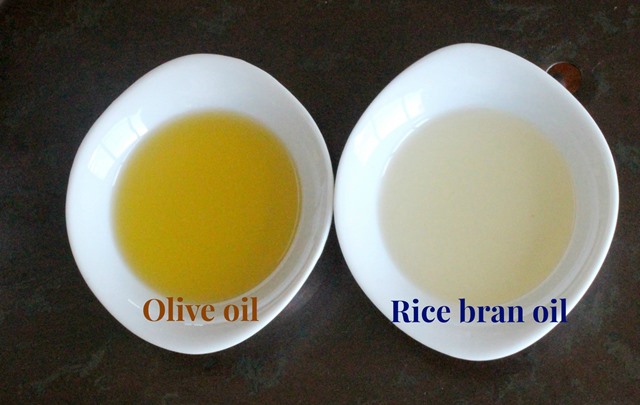- Home
- Blog
- Fats and oils
- Q. How does rice bran oil compare to olive oil?
Q. How does rice bran oil compare to olive oil?
Written by Catherine Saxelby
on Tuesday, 18 June 2013.
Tagged: cholesterol, fat, grains, healthy cooking, healthy heart, oil, salad

Q. I was wondering how rice bran oil compares to virgin olive oil for good fats, antioxidants, cholesterol-lowering effects, etc. From what I've read on the labels, they sound pretty good and have been using both in my cooking. What's your opinion?
A. Rice bran oil is a healthy oil and compares well to olive oil except for the cold-pressing which I cover below.
Much of the advertising for rice bran oil is a little extreme with claims that trumpet it is "The World's Healthiest Oil" but in reality its nutrition profile is similar to other oils. There's only a couple of points of difference over other oils.
How rice bran oil is similar
Like other liquid oils, rice bran oil is free of trans fats and relatively low in saturated fat (20%), although not as low as canola (8%) or olive oil (14%).
It contains 32% polyunsaturates and 40% monounsaturated which makes it similar in composition to cottonseed or sesame oil. This alone will ensure that it lowers cholesterol - as other oils do.
What makes rice bran oil stand out
Rice bran oil is high in two unusual compounds called oryzanol and tocotrienols. Other oils don't have much - if any - of these two.
Rice bran oil is high in two unusual compounds called oryzanol and tocotrienols. Other oils don't have much - if any - of these two.
- Oryzanol been shown to block the absorption of cholesterol into the body. It acts like the cholesterol-lowering margarines (e.g. Heart Plus and Pro-activ). These have the sterols added and the sterols are generally derived from soy.
- Tocotrienols are a group of related fat-soluble compounds that are converted into vitamin E which is a well-researched antioxidant for the heart. They're a form of the vitamin that hasn't been as widely researched as the more well-known alpha-tocopherol form. While corn, wheatgerm and soybeans contain tocopherols, tocotrienols are found in palm and rice bran oils (as well as barley, oats).
Rice bran oil - how it cooks
In the kitchen, rice bran oil is very stable and makes a good oil for pan-frying.

It has a high smoke point so you can cook at higher temperatures without it starting to smoke and break down (something to avoid with oils). Remember though, it's still refined and stabilized - like almost all other oils - and it's often the case that the more refined the oil the higher the smoke point.
This is where extra virgin olive oil has the edge - it's cold-pressed, so no heat is used to extract it which means it retains its natural antioxidants and vitamins. It's more ‘natural' which appeals to many these days.
However unless it's good quality, it's not the ideal choice for cooking at high temperatures and many cooks tell me that it tends to ruin their non-stick pans (something I've noticed too over the life of many a non-stick pan!).
So if you have to eat a heart healthy diet, rice bran oil would be good to buy for stir-frying and sautéeing at high heat while you reserve your extra virgin olive oil for low-temp pan-cooking and splashing over cooked vegetables - as the Italians do.
Jemma O'Hanlon
The Good Stuff
The Boring Stuff
© 2025 Foodwatch Australia. All rights reserved
Website by Joomstore eCommerce









